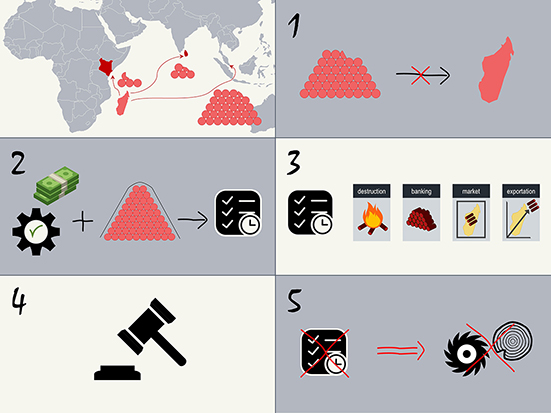CITES must take urgent action to save Madagascar’s unique species of rosewood and ebony
Keywords:
CITES, ebony, rosewood, Madagascar, illegal logging, criminal syndicates, timber trade, Dalbergia, DiospyrosAbstract
This contribution is an open letter to all CITES Management and Scientific Authorities, which is signed by all of the co-authors. As CITES convenes its 19th Conference of the Parties in November 2022, some of the largest seizures in history of illegally harvested CITES-listed species are poised to be handed back to the criminals who smuggled them out of Madagascar. Nearly 40,000 rosewood logs were illegally exported from the country in 2014, in clear violation of CITES and national embargos, as explicitly declared in Notices issued by the CITES Secretariat. The logs were seized by Singapore, Kenya, and Sri Lanka, but as a result of both passive and active interference from various Malagasy officials and aggressive use of these countries’ national court and political systems, orders have now been issued for the logs to be returned to the smugglers. Release of this wood would have catastrophic consequences for the future sustainable management of Madagascar’s remaining rosewood and ebony resources. We propose five essential steps that should be taken at the upcoming CITES CoP 19 in Panama to prevent this from happening.
Résumé
Cette contribution est une lettre ouverte adressée à toutes les instances scientifiques et de gestion de la CITES, qui est signée par tous les co-auteurs. Alors que la CITES convoque sa 19e Conférence des Parties, en novembre 2022, plusieurs saisies importantes, les plus volumineuses de l’histoire dans un cas, d’espèces inscrites à la CITES et exploitées illégalement sont sur le point d'être rendues aux criminels qui les ont fait sortir clandestinement de Madagascar. Près de 40 000 rondins de bois de rose ont été sortis en contrebande de Madagascar en 2014, en violation flagrante de la CITES et des embargos nationaux, comme le déclarent explicitement les avis émis par le Secrétariat de la CITES. Ces rondins de bois de rose ont été saisis par les autorités douanières de Singapour, du Kenya et du Sri Lanka, mais suite à une ingérence active et passive de divers fonctionnaires du gouvernement de Madagascar et un usage agressif des systèmes judiciaires et politiques nationaux des pays dans lesquels les saisies ont eu lieu, l’ordre a maintenant été donné de restituer ces rondins aux contrebandiers. Nous énumérons ici cinq mesures essentielles qui doivent être prises lors de la prochaine CdP 19 à Panama pour empêcher que cela ne se produise.References
Butler, R. A. 2014. Singapore intercepts massive illegal shipment of Madagascar rosewood. Mongabay. Available online <https://news.mongabay.com/2014/06/singapore-intercepts-massive-illegal-shipment-of-madagascar-rosewood/>
CITES 2017. SC69 Doc. 49.2. Available online <https://cites.org/sites/default/files/eng/com/sc/69/E-SC69-49-02.pdf>
CITES 2019. Current status of Malagasy rosewood logs seized by Singapore in March 2014 and advisory on rosewood stockpile originating from Madagascar. CITES No. 2019/051; Geneva, 26 September 2019. Available online <https://cites.org/eng/node/55184>
CITES 2022a. Current status of Malagasy rosewood logs seized by Kenya in May 2014 and advisory on rosewood stockpile originating from Madagascar. CITES No. 2022/005; Geneva, 20 January 2022. Available online <https://cites.org/eng/node/130016>
CITES 2022b. Malagasy ebonies (Diospyros spp.) and palisanders and rosewoods (Dalbergia spp.) (Decision 18.98). Report of Madagascar (Decision 18.96). Available online <https://cites.org/sites/default/files/eng/com/sc/74/E-SC74-28-03-01.pdf>
CITES 2022c. Malagasy ebonies (Diospyros spp.) and palisanders and rosewoods (Dalbergia spp.) (Decision 18.98). Report of the Secretariat (Decisions 18.94 and 18.99). Available online <https://cites.org/sites/default/files/eng/com/sc/74/E-SC74-28-03-02.pdf>
EIA (Environmental Investigation Agency) and TI (Transparency International). 2022. Convention evasion: Madagascar's plan to pull rosewood stockpiles out of CITES. Washington DC. Available online <https://us.eia.org/report/20220303-convention-evasion-madagascars-plan-to-pull-rosewood/>
Interpol (International Criminal Police Organization). 2021. Forestry Crime. Available online <https://www.interpol.int/en/Crimes/Environmental-crime/Forestry-crime>
Lowry II, P. P., Phillipson, P. B., Rakouth, H., Andriambololonera, S., Rabarimanarivo, M. and Manjato, N. 2022. Large tree species of Diospyros from Madagascar. Catalogue of Plants of Madagascar. Available online <http://legacy.tropicos.org/projectwebportal.aspx?pagename=Diospyros_LT&projectid=17>
Mason, J., Parker, M., Vary, L. B., Lowry II, P. P., Hassold, S. and Ruta, G. 2016. Malagasy precious hardwoods: scientific and technical assessment to meet CITES objectives. The World Bank, Washington DC. Available online <https://www.profor.info/content/malagasy-precious-hardwoods-scientific-and-technical-assessment-meet-cites-objectivesWorld Bank 2016>
Nellemann, C., Henriksen, R., Raxter, P., Ash, N. and Mrema, E. (eds). 2014. The Environmental Crime Crisis: Threats to Sustainable Development from Illegal Exploitation and Trade in Wildlife and Forest Resources. A UNEP Rapid Response Assessment. United Nations Environment Programme and GRID-Arendal, Nairobi and Arendal. Available online <https://www.grida.no/publications/178>
Phillipson, P. B., Wilding, N., Crameri, S., Andriambololonera, S., Rakotonirina, N., Rabarimanarivo, M. and Manjato, N. 2022. Large tree species of Dalbergia from Madagascar. Catalogue of the Plants of Madagascar. Available online <http://legacy.tropicos.org/projectwebportal.aspx?pagename=Dalbergia_LT&projectid=17>
Randriamalala, H. & Liu, Z. 2010. Rosewood of Madagascar: Between democracy and conservation. Madagascar Conservation & Development 5, 1: 11–22. <https://doi.org/10.4314/mcd.v5i1.57336>
Waeber, P. O., Schuurman, D., Ramamonjisoa, B., Langrand, M., Barber, C. V., Innes, J. L., Lowry II, P. P. and Wilmé, L. 2019. Uplisting of Malagasy precious woods critical for their survival. Biological Conservation 235: 89–92. <https://doi.org/10.1016/j.biocon.2019.04.007>
Wilmé, L., Innes, J. L., Schuurman, D., Ramamonjisoa, B., Langrand, M., Barber, C. V., Butler, R. A., Wittemyer, G. and Waeber, P. O. 2020. The elephant in the room: Madagascar’s rosewood stocks and stockpiles. Conservation Letters 13, 4: e12714. <https://doi.org/10.1111/conl.12714>

Downloads
Published
Issue
Section
License
All journal content, except where otherwise noted, is licensed under a creative common Attribution 4.0 International and is published here by the Indian Ocean e-Ink under license from the author(s).


